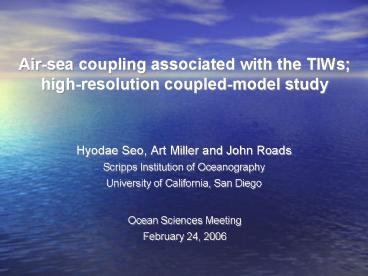Airsea coupling associated with the TIWs highresolution coupledmodel study PowerPoint PPT Presentation
1 / 17
Title: Airsea coupling associated with the TIWs highresolution coupledmodel study
1
Air-sea coupling associated with the TIWs
high-resolution coupled-model study
- Hyodae Seo, Art Miller and John Roads
- Scripps Institution of Oceanography
- University of California, San Diego
Ocean Sciences Meeting February 24, 2006
2
Outline
- Introduce the regional coupled model.
- Describe how the atmosphere responses to SST by
TIWs. - Discuss how the perturbed atmosphere feeds back
on TIWs. - Summary
3
Regional coupled model
4
Regional coupled model and experiment
Model Domain
SCOAR Model
Atmos
Ocean
?
?
Flux
?
?
SST
?
?
Lateral BC Ocean analysis / climatology
IC and Lateral BC NCEP/DOE Reanalysis
Seo, Miller and Roads (submitted to J. Climate,
2005)
Purpose Study air-sea coupled feedback arising
in the presence of ocean mesoscale eddies,
fronts, and filaments
5
Atmospheric response to SST
6
Stability adjustment within the ABL due to SST
CEOF 1 of SST and WS Vector
? Lower atmosphere is less stratified over warm
water. ? Subsequently, increase in turbulent
mixing accelerates surface winds.
7
Modification of heat and momentum flux
Change in dynamic state
Change in thermal state
Coupling of SST and Wind stress
WSD
WSC
LH anomaly ?20W / m2 Div and curl anomaly ?
2N/m2 per 100km
- Turbulent (and perhaps radiative) flux damps the
SST a negative feedback! - Feedback from wind stress perturbation remains
largely unknown!
8
Effect of atmospheric feedback on TIWs
9
Effect of additional atmospheric feedback
? A question still remains How do the perturbed
heat and wind feed back on temperature of TIWs?
? Additional experiments sensitivity test for
the year of 1999
temporally smoothed using 120-day moving mean
- Analysis using the first two EOFs and PCs of
ocean temperature - We are interested in....
- from EOFs, changes in amplitude and wavelength
of zonal temperature fluctuations by TIWs. - from PCs, changes in frequency of the TIWs.
10
Changes in amplitude of zonal SST fluctuation
mean of 1st and 2nd modes
- TIWs are evident under climatological forcing.
- Heat flux coupling causes a negative damping to
fluctuation of SST by TIWs. - Wind coupling leads to a stronger damping also
increases wavelength. (cf. Pezzi et al., 2002) - Full-coupling results in further weaker zonal
fluctuation of SST over the TIW region.
EOF from September to December, 1999 over
1?S-6?N, 130?W-100?W.
11
Changes in vertical distribution
Average over 1?N-6?N
Zonal STD of temperature
Depth (m)
Zonal STD of temperature (?C)
- TIWs are largely uniform in upper ocean
- Heat flux coupling thermal damping increases
baroclinicity in the mixed layer - Wind coupling damping increase in wavelength.
- Full-coupling mixture of effects from wind and
heat feedback
CLM EOF-1 41 (2nd 35, Total ? 76)
Depth (m)
Longitude
12
Changes in wavenumber and frequency
characteristics
Average of 1st and 2nd PCs Average of 1?N-6?N
- Coupling increases the period of waves.
- Dynamic coupling increases the wavelength of the
wave.
13
Summary
- Coupled model reproduces the observed atmospheric
responses to the TIWs Evolving SSTs induce
stability adjustment and thus changes in heat
flux and wind stress.
- Series of fully coupled, partially coupled, and
uncoupled experiment show that ... - 1) as expected, heat flux feedback suppresses
amplitude of SST fluctuation by TIWs a negative
feedback - 2) dynamic feedback provides even stronger
damping to SST fluctuation! (cf. Pezzi et al.,
2002) - 3) surface damping of temperature by heat flux
results in stronger baroclinicity of zonal
temperature fluctuation. - 4) dynamic feedback mostly increases the
wavelength of the wave dynamic property of wave.
14
Comments or questions?Thanks!
15
Extra Slides
16
STD of temperature reconstructed from 1st and 2nd
modes
STD of SST
STD of temperature in vertical
17
EOF analysis of SST
EOF from September to December, 1999 over
1?S-6?N, 130?W-100?W.
CLM EOF 1 34.2
PC 1
- 1st and 2nd EOFs and PCs are paired and directly
related to TIWs, explaining more than 60 of the
total variance.
CLM EOF 2 30.5
PC 2
CLM EOF 3 9.3
- We are interested in....
- from EOFs, changes in amplitude and wavelength
of zonal temperature fluctuations by TIWs. - from PCs, changes in frequency of TIWs.
PC 3
CLM EOF 4 6.6
PC 4

